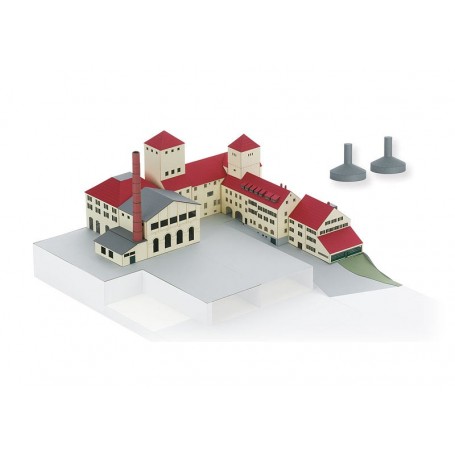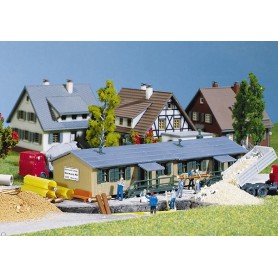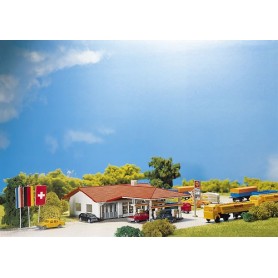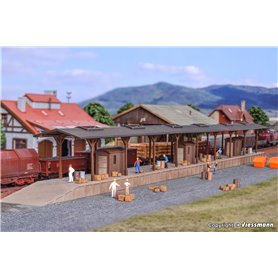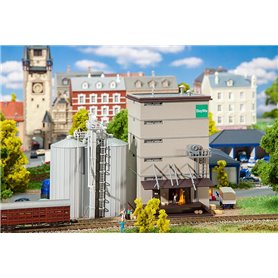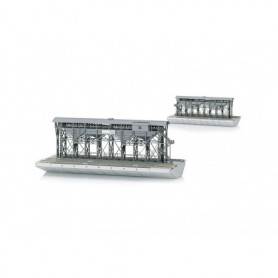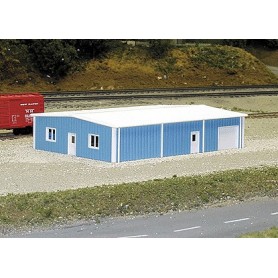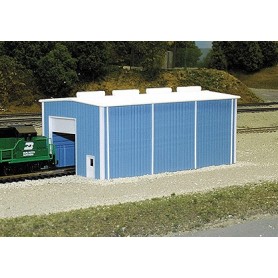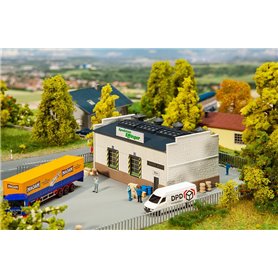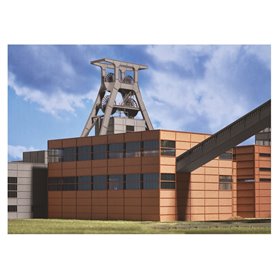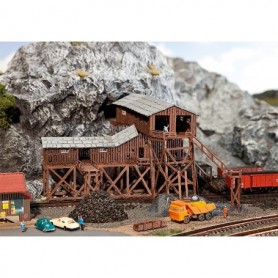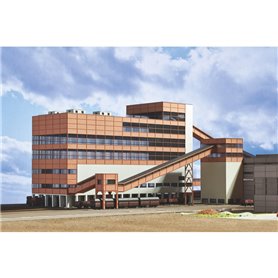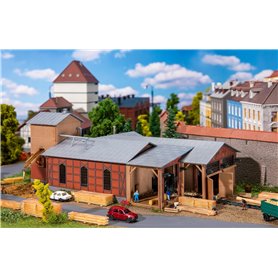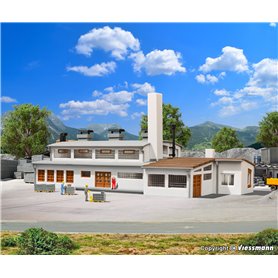Bryggeri "Weihenstephan" Part 1
Bryggeri 'Weihenstephan' Part 1
Bevaka artikel
-
 Betala säkert i vår webshop!
Betala säkert i vår webshop!
Beskrivning
Bryggeri 'Weihenstephan' Part 1.
Model: 'Weihenstephan' Brewery Kit Part 1 includes the following buildings (basic dimensions in parentheses): -
Administration building with mural (182 x 72 mm / 7-3/16' x 2-7/8'). -
Entrance with tower (62 x 72 mm / 2-7/16' x 2-7/8'). -
Seminar building (118 x 109 mm / 4-5/8' x 4-1/4'). -
Brew house with chimney (191 x 88 mm / 7-1/2' x 3-1/2'). -
Residential building with corridor (176 x 66 mm / 6-15/16' x 2-5/8'). -
Beer pub (126 x 85 mm / 4-15/16' x 3-3/8'). -
Substructure (410 x 410 mm / 16-1/8' x 16-1/8').
Part 2 available under item number 66321 is required to represent the brewery as it currently looks. This kit consists of laser-cut, colored architectural hard cardstock. It has the finest laser-engraved details. Extensive instructions for building the kit are included.
Highlights: The oldest brewery in Germany for the first time as a model in 1:160 scale.
This kit is being produced in a one-time series as part of the anniversary '500 Years of the German Beer Purity Law'.
T66320 Weihenstephan Brewery T66321 Weihenstephan Brew House Beer lovers have appreciated it for a long time, the full-bodied beers of the Bavarian State Brewery Weihenstephan. It has a long tradition. The founding of a Benedictine cloister in 725 by the holy Korbinian with his twelve followers on the Nährberg near Freising was at the beginning of the art of brewing in Weihenstephan. Since brewing was done in most of the cloisters in the Middle Ages, it is a safe assumption that brewing was done in the Weihenstephan cloister also. Anyway, there were people with hops gardens in the area with tithing obligations owed to the cloister. According to the legend, the monks of Weihenstephan certainly brewed their beer until 1040 but were in competition with the inhabitants of Freising. In this year, Abbot Arnold is supposed to have succeeded in dispossessing the inhabitants of Freising of the right to brew and to serve beer. This is when the cloister brewery of Weihenstephan is supposed to have originated. Indeed today, it is known that all of this really belongs to the realm of fables, but there is the indisputable fact that beer brewing has been going on for centuries at Weihenstephan. Yet over the course of centuries, the cloister was visited constantly by the vicissitudes of fate. In 955, the Huns plundered and destroyed the cloister. In 1336, Kaiser Ludwig the Bavarian rampaged in the same manner, as did the Swedes and the French in the Thirty Years War as well as the Austrians and the Spanish in the War of the Spanish Succession. Furthermore, between 1085 and 1463 the Weihenstephan Cloister was the victim of a conflagration four times. In addition, three plague epidemics raged, there were different periods of famine, and a large earthquake occurred in 1348, which brought additional destruction or decreases in population. Yet Bavarian persistence kept helping the Benedictines rebuild the cloister and the brewery and even to refine their art of brewing in the process. However, secularization on March 24, 1803 brought the death knell for the cloister. All ownership and rights for the cloister were transferred to the Bavarian State. The brewery remained intact and it was now managed by the Royal Crown Lands office in Schleissheim. The Agricultural Central School in Schleissheim moved in 1852 to Weihenstephan and with it came Bavarian brewery students. An academy was formed out of the school in 1895. In 1919, came the Technical School for Agriculture and Brewing and around 1930 it was a component part of the Technical University of Munich. The center of German, even worldwide brewing technology, thus came into being in Weihenstephan. After World War II, the quickly increasing beer production was overwhelming the time-honored brewery with its old buildings. Extensive renovation of the brewery building, the fermentation tanks, and the cellar buildings was carried out. Today marvelous beer products are guaranteed with the latest technology.
Trix Nyhet 2016.
Model: 'Weihenstephan' Brewery Kit Part 1 includes the following buildings (basic dimensions in parentheses): -
Administration building with mural (182 x 72 mm / 7-3/16' x 2-7/8'). -
Entrance with tower (62 x 72 mm / 2-7/16' x 2-7/8'). -
Seminar building (118 x 109 mm / 4-5/8' x 4-1/4'). -
Brew house with chimney (191 x 88 mm / 7-1/2' x 3-1/2'). -
Residential building with corridor (176 x 66 mm / 6-15/16' x 2-5/8'). -
Beer pub (126 x 85 mm / 4-15/16' x 3-3/8'). -
Substructure (410 x 410 mm / 16-1/8' x 16-1/8').
Part 2 available under item number 66321 is required to represent the brewery as it currently looks. This kit consists of laser-cut, colored architectural hard cardstock. It has the finest laser-engraved details. Extensive instructions for building the kit are included.
Highlights: The oldest brewery in Germany for the first time as a model in 1:160 scale.
This kit is being produced in a one-time series as part of the anniversary '500 Years of the German Beer Purity Law'.
T66320 Weihenstephan Brewery T66321 Weihenstephan Brew House Beer lovers have appreciated it for a long time, the full-bodied beers of the Bavarian State Brewery Weihenstephan. It has a long tradition. The founding of a Benedictine cloister in 725 by the holy Korbinian with his twelve followers on the Nährberg near Freising was at the beginning of the art of brewing in Weihenstephan. Since brewing was done in most of the cloisters in the Middle Ages, it is a safe assumption that brewing was done in the Weihenstephan cloister also. Anyway, there were people with hops gardens in the area with tithing obligations owed to the cloister. According to the legend, the monks of Weihenstephan certainly brewed their beer until 1040 but were in competition with the inhabitants of Freising. In this year, Abbot Arnold is supposed to have succeeded in dispossessing the inhabitants of Freising of the right to brew and to serve beer. This is when the cloister brewery of Weihenstephan is supposed to have originated. Indeed today, it is known that all of this really belongs to the realm of fables, but there is the indisputable fact that beer brewing has been going on for centuries at Weihenstephan. Yet over the course of centuries, the cloister was visited constantly by the vicissitudes of fate. In 955, the Huns plundered and destroyed the cloister. In 1336, Kaiser Ludwig the Bavarian rampaged in the same manner, as did the Swedes and the French in the Thirty Years War as well as the Austrians and the Spanish in the War of the Spanish Succession. Furthermore, between 1085 and 1463 the Weihenstephan Cloister was the victim of a conflagration four times. In addition, three plague epidemics raged, there were different periods of famine, and a large earthquake occurred in 1348, which brought additional destruction or decreases in population. Yet Bavarian persistence kept helping the Benedictines rebuild the cloister and the brewery and even to refine their art of brewing in the process. However, secularization on March 24, 1803 brought the death knell for the cloister. All ownership and rights for the cloister were transferred to the Bavarian State. The brewery remained intact and it was now managed by the Royal Crown Lands office in Schleissheim. The Agricultural Central School in Schleissheim moved in 1852 to Weihenstephan and with it came Bavarian brewery students. An academy was formed out of the school in 1895. In 1919, came the Technical School for Agriculture and Brewing and around 1930 it was a component part of the Technical University of Munich. The center of German, even worldwide brewing technology, thus came into being in Weihenstephan. After World War II, the quickly increasing beer production was overwhelming the time-honored brewery with its old buildings. Extensive renovation of the brewery building, the fermentation tanks, and the cellar buildings was carried out. Today marvelous beer products are guaranteed with the latest technology.
Trix Nyhet 2016.
Specifikation
- Skala
- 1:160
Relaterade produkter
16 andra produkter i samma kategori:

